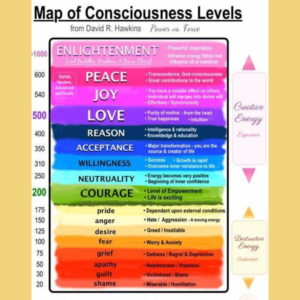The scale of consciousness
David Hawkins created the scale of consciousness, a framework for understanding human emotions and behaviours based on their levels of energy and frequency. Each level on the scale represents a different state of consciousness, which is associated with different emotions, thoughts, and behaviours.
The scale ranges from 0 to 1000, with 0 being the lowest level of consciousness and 1000 being the highest. The levels are grouped into three main categories: lower, middle, and higher consciousness.
At lower levels of consciousness (below 200), people tend to experience negative emotions such as fear, anger, and shame. They may also engage in behaviours that are harmful to themselves and others, such as violence or addiction.
At the middle levels of consciousness (200-500), people experience more positive emotions such as love, joy, and peace. They are more likely to engage in behaviours that benefit themselves and others, such as acts of kindness or creativity.
At the highest levels of consciousness (above 500), people experience states of enlightenment, transcendence, and unity. They are able to access profound insights and spiritual experiences that go beyond the limitations of the ego and the material world.
Hawkins’ scale is meant to provide a framework for personal growth and spiritual development. By understanding the levels of consciousness and where we currently fall on the scale, we can begin to make positive changes in our lives and work towards higher levels of consciousness.

Going from low consciousness to high consciousness is a journey that requires dedication, effort, and commitment to personal growth and spiritual development. Here are some ways to move up the scale of consciousness:
- Awareness: The first step towards higher consciousness is becoming aware of your current level of consciousness. Pay attention to your thoughts, emotions, and behaviours, and identify any patterns that are holding you back.
- Self-reflection: Take time to reflect on your life, values, and beliefs. Identify areas where you would like to make positive changes and set goals for yourself.
- Self-care: Take care of your physical, emotional, and spiritual needs. This may include regular exercise, meditation, therapy, or spending time in nature.
- Gratitude: Cultivate an attitude of gratitude and appreciation for the blessings in your life. This can help shift your focus from negative to positive emotions.
- Compassion: Practice compassion and empathy towards yourself and others. This can help you develop a greater sense of connection and understanding.
- Mindfulness: Practice mindfulness and living in the present moment. This can help you develop greater awareness and acceptance of your thoughts and emotions.
- Service: Engage in acts of service and volunteerism. This can help you develop a greater sense of purpose and connection to others.


